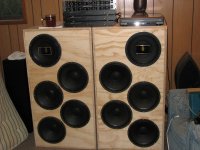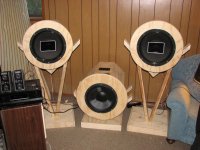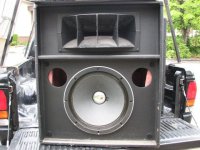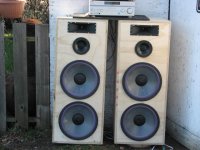I'm curious as to how many board members use active crossovers?
At least a 2 way?
How about 3 way systems ?
With a full blown 4 way, being of course, the cat's meow
I'm curious on this because, it seems to me, that around 1980 there were several active crossovers on the market, but these days, other than Marchand, not so much. Or am I missing something ?
At least a 2 way?
How about 3 way systems ?
With a full blown 4 way, being of course, the cat's meow
I'm curious on this because, it seems to me, that around 1980 there were several active crossovers on the market, but these days, other than Marchand, not so much. Or am I missing something ?
Yes. I use a large three way active system.
JBL ASB6118 ( 18" subs ), JBL AL6115 ( 15" low mid ), Altec 511B with 808-8a compression driver. Crossover points are 100Hz and 900 Hz, using a Behringer DCX2496.
Other options for crossovers exist, like Jriver and other PC software based crossovers. These can use things like USB to multiple D/A controllers ( Tascam 16x08, Focusrite 18i20 ) among other options.
Equalization is necessary.
JBL ASB6118 ( 18" subs ), JBL AL6115 ( 15" low mid ), Altec 511B with 808-8a compression driver. Crossover points are 100Hz and 900 Hz, using a Behringer DCX2496.
Other options for crossovers exist, like Jriver and other PC software based crossovers. These can use things like USB to multiple D/A controllers ( Tascam 16x08, Focusrite 18i20 ) among other options.
Equalization is necessary.
Last edited:
Hi,
Yes. Its simply not cost effective to go active with decent amplifiers.
Nevermind every active x/o needs to match the speakers.
Two way active is particularly not cost effective.
3 way active bass to mid and passive mid to treble with active EQ
its starts to make a lot more sense, but not easy to design.
rgds, sreten.
Yes. Its simply not cost effective to go active with decent amplifiers.
Nevermind every active x/o needs to match the speakers.
Two way active is particularly not cost effective.
3 way active bass to mid and passive mid to treble with active EQ
its starts to make a lot more sense, but not easy to design.
rgds, sreten.
Fully active 4-way SWMTMWS with MiniDSP. XLS12, SS26W, SS15W & Raal 70-20.
Sounds amazing and a lot easier to implement than a passive solution, cheaper too I would imagine, the passive crossovers would be more expensive than the drivers...
Another BIG advantage, at least for me, is that I can use the DSP/amp-package and play with filters in virtually any other system I want to test/play with. Then it's just to reconfigure the crossover again.
Sounds amazing and a lot easier to implement than a passive solution, cheaper too I would imagine, the passive crossovers would be more expensive than the drivers...
Another BIG advantage, at least for me, is that I can use the DSP/amp-package and play with filters in virtually any other system I want to test/play with. Then it's just to reconfigure the crossover again.
FYI.
Yes, (very) actif.
In DIM (since 1970):
5-way full horn system (2x5). EV Patrician IV / WE66A / Iwata 2" / Iwata 1" / Beyma
5 amps BJT (& DC servo/control) (2x5)
5 way actif X-over (2x5). 2x5 Actif analog (IC) filter type L-R, 24dB/oct.
Fr @ 250Hz/1200Hz/7000Hz/10kHz
(One musical note: with passive X-over ... a never ending tuning story)
It's music ... I like it ..
Yes, (very) actif.
In DIM (since 1970):
5-way full horn system (2x5). EV Patrician IV / WE66A / Iwata 2" / Iwata 1" / Beyma
5 amps BJT (& DC servo/control) (2x5)
5 way actif X-over (2x5). 2x5 Actif analog (IC) filter type L-R, 24dB/oct.
Fr @ 250Hz/1200Hz/7000Hz/10kHz
(One musical note: with passive X-over ... a never ending tuning story)
It's music ... I like it ..
Yes. MinDSP 2x4 and dual TPA3116D2 gives stereo 2-way. I also have second setup identical so I can run stereo 4-way. Works great and never going back to passives.
Cost is a lot less than you think when you factor infinite reuse for new projects without buying more components. $120 cost for 2-way stereo.
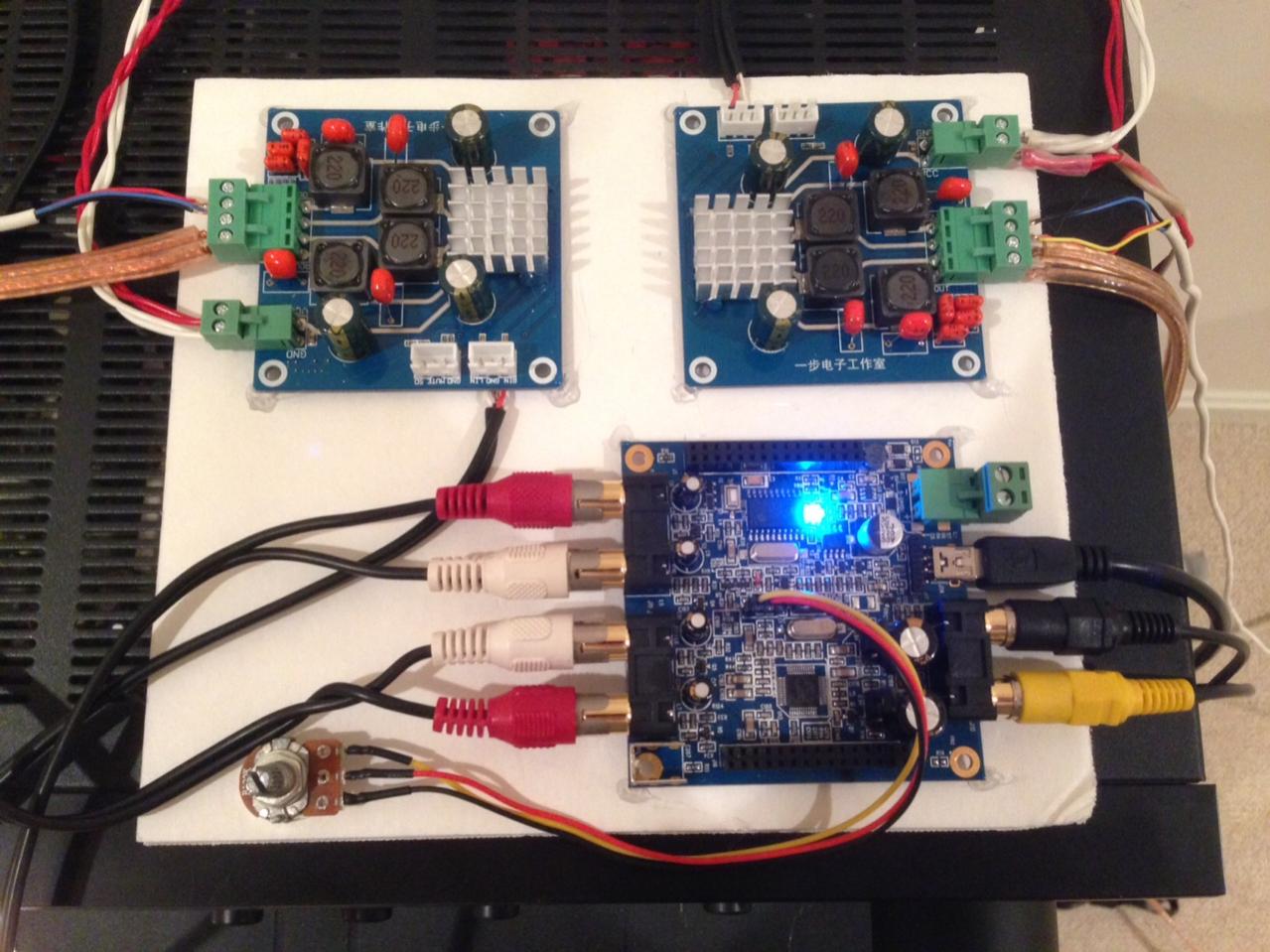
Cost is a lot less than you think when you factor infinite reuse for new projects without buying more components. $120 cost for 2-way stereo.

$way active.
Drivers are Volt R3143, Tannoy K3149 and Fountek JP3.0.
Crossover points 250Hz, 1200Hz and 15kHz.
Crossovers modified BSS FDS30 and amps are
Quested AP700 (MC2 MC650), Tannoy TA450 (MC2 MC450), MC2 T500, Omniphonics Footprint 150 (BeyerDynamic Blueprint).
Additionally I use an ARX MultiQ parametric equalizer to mimic the Tannoy xovers transfer function.
Drivers are Volt R3143, Tannoy K3149 and Fountek JP3.0.
Crossover points 250Hz, 1200Hz and 15kHz.
Crossovers modified BSS FDS30 and amps are
Quested AP700 (MC2 MC650), Tannoy TA450 (MC2 MC450), MC2 T500, Omniphonics Footprint 150 (BeyerDynamic Blueprint).
Additionally I use an ARX MultiQ parametric equalizer to mimic the Tannoy xovers transfer function.
Hi,
The OP is referring to the open hifi market, and not DIY
AFAICT, and thus my answer is based on that market.
Active has lots of problems for a clueless hifi punter.
It did peak in the 1980's, as a fashion, like planar
square drivers did, but didn't deliver the goods
as an upgrade path. There are some fine fully
active speakers from the period that did.
And still now are, like the Event Opal's.
rgds, sreten.
I'm on a hiding to nothing, with the active
brigade chipping in, and the non-active not.
Which will never answer the OP's question.
The OP is referring to the open hifi market, and not DIY
AFAICT, and thus my answer is based on that market.
Active has lots of problems for a clueless hifi punter.
It did peak in the 1980's, as a fashion, like planar
square drivers did, but didn't deliver the goods
as an upgrade path. There are some fine fully
active speakers from the period that did.
And still now are, like the Event Opal's.
rgds, sreten.
I'm on a hiding to nothing, with the active
brigade chipping in, and the non-active not.
Which will never answer the OP's question.
Last edited:
I'm sure coils and caps are even harder for the average audiophile to master.
Hi,
There is a perception active makes things easier. But you have
to master coils and caps to see that its only marginally easier,
and not miss the pitfalls of assuming its easier. Only then IMO
can you use active wisely to its full and proper potential IMO.
rgds, sreten.
http://www.musicanddesign.com/HybridDesign.html
Note the above is a passive two way with active EQ.
It makes far more sense than an active two way.
And it would be the basis of the passive mid/treble with active EQ
than allows a 3 way to use two near equal power ampliers for
the bass and mid/treble with an active bass to mid/treble x/o.
Last edited:
I'm starting down the path, well collecting the bits anyway. Of the commercial actives I have heard, the only ones I liked were the meridian D6000 and the ATC SCM100A, both a bit spendy.
My choice to go active was based on a number of factors, not least that I have fallen out of love with my power amp and have used that excuse to plan a complete replacement of the amplification. But it will take me some time as funds are limited and I don't want to rush as I'm doing something unusual (and possibly daft). But I'm fed up with being sensible.
My choice to go active was based on a number of factors, not least that I have fallen out of love with my power amp and have used that excuse to plan a complete replacement of the amplification. But it will take me some time as funds are limited and I don't want to rush as I'm doing something unusual (and possibly daft). But I'm fed up with being sensible.
Hi,
There is a perception active makes things easier. But you have
to master coils and caps to see that its only marginally easier,
and not miss the pitfalls of assuming its easier. Only then IMO
can you use active wisely to its full and proper potential IMO.
rgds, sreten.
Hybrid Design
Note the above is a passive two way with active EQ.
It makes far more sense than an active two way.
And it would be the basis of the passive mid/treble with active EQ
than allows a 3 way to use two near equal power ampliers for
the bass and mid/treble with an active bass to mid/treble x/o.
Yep, that is a smart way of doing it, I have a pair of NaO Note with passives in the top and active eq and w/m crossover. But why not go all the way as JohnK did in his Note II?
I'm curious as to how many board members use active crossovers?
At least a 2 way?
Yep, I use a couple of 2-way active systems. I use active because it makes the amp design job that much easier. For example using a classD up to 3kHz sounds decent but the cheapo classD chip I use doesn't sound good all the way to 18kHz. Class AB on the tweeter is barely delivering any power anyway so the heatsinks are very small ones.
Hi,
Being sensible is having a plan, like reusing your power amplifier.
There are lots of possibilities, with lots of different results.
Here is a wacky suggestion for for doing a two way very differently
without going active assuming that your speakers are biwireable.
Get a nice little amplifier (class A tranny or valve) and reduce
the input capacitor so it rolls off at -3dB at say 800Hz, and
then use that to drive the treble unit via its crossover.
At the same time from its output build an attenuator with
an inverse rise to its rolloff to drive the input of the original
power amplifier, which is then used to drive the bassmid
via its crossover to get back to original, with balanced levels.
The net result for sure will be more low frequency noise,
but the small amplifier should basically define the sound.
It won't have missed some the same thing can be done
much lower down for driving speakers and adding a sub
where the main system has no low pass, and you wan't
to add one to the main amplifier, and derive the correct
signal to drive the sub, no real noise issues here at all.
rgds, sreten.
Being sensible is having a plan, like reusing your power amplifier.
There are lots of possibilities, with lots of different results.
Here is a wacky suggestion for for doing a two way very differently
without going active assuming that your speakers are biwireable.
Get a nice little amplifier (class A tranny or valve) and reduce
the input capacitor so it rolls off at -3dB at say 800Hz, and
then use that to drive the treble unit via its crossover.
At the same time from its output build an attenuator with
an inverse rise to its rolloff to drive the input of the original
power amplifier, which is then used to drive the bassmid
via its crossover to get back to original, with balanced levels.
The net result for sure will be more low frequency noise,
but the small amplifier should basically define the sound.
It won't have missed some the same thing can be done
much lower down for driving speakers and adding a sub
where the main system has no low pass, and you wan't
to add one to the main amplifier, and derive the correct
signal to drive the sub, no real noise issues here at all.
rgds, sreten.
Last edited:
You're probably missing something...the cinema world went digital active a long time ago if you missed it.I'm curious as to how many board members use active crossovers? At least a 2 way? How about 3 way systems ?...
I'm curious on this because, it seems to me, that around 1980 there were several active crossovers on the market, but these days, other than Marchand, not so much. Or am I missing something ?
I'm using a Yamaha SP2060 on my fronts (TAD TD-4002 2-way Jubilees), an EV Dx38 on my center JuBelle 3-way, another Dx38 on my bi-amped surround Cornwalls, and the DSP front ends on a couple of XTi-1000s driving my DIY TH subs (modified SPUDs). They have transformed my 5.2 array. I'm with S. Linkwitz on this subject--I don't see much use in passives other than they can be cheaply implemented (but often aren't). Too much hype and nostalgia in passives...and they don't really work very well.
Last edited:
- Status
- This old topic is closed. If you want to reopen this topic, contact a moderator using the "Report Post" button.
- Home
- Loudspeakers
- Multi-Way
- Are you ACTIVE ?? (multi-way)
